Clabby WwTW (2021)
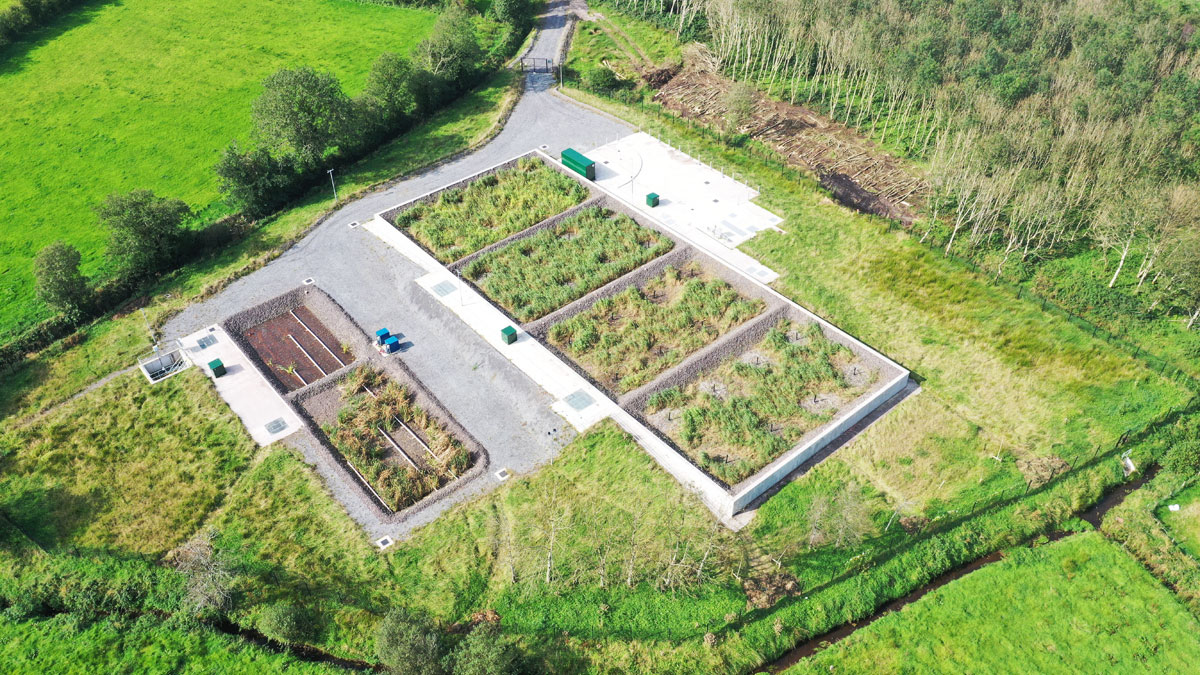
Clabby WwTW: September 2020 - Courtesy of BSG Civil Engineering Ltd
Clabby is a rural village located approximately 5km from Fivemiletown on the border between Counties Tyrone and Fermanagh. The existing wastewater treatment works was constructed in 2002 on the outskirts of the village with a design PE of 271 for a Water Order Consent (WOC) of 23:30 (BOD:SS). With a current PE of 450, the existing works was clearly insufficient to treat future design capacity and therefore was restricting development within the Clabby catchment.
Need for improvements
The WOC was reviewed in 2013 to 10:10:3 (BOD:SS:Ammonia), for a conventional process at the existing discharge location. However spatial constraints limited the options to extend the existing process. The current discharge location was no longer an option, however there was potential to discharge to a tributary of Many Burns, approximately 5km away. The design PE of 750 was confirmed for the Clabby works. With the existing site too small to extend, and the nearest works at Fivemiletown already at capacity, it was concluded that additional lands were required to construct a new works.
Project drivers
NI Water strive to install greener solutions where possible and the upgrade of Clabby allowed the consideration of options which could reduce energy demands, optimise operational/maintenance costs and reduce sludge transportation.
With RPS as project managers, an integrated constructed wetland (ICW) was the initial solution to be recommended, with NI Water having completed successful ICW schemes at Stoneyford and Castle Archdale.
The Northern Ireland Environment Agency (NIEA) offered a WOC of 13:20:3 (BOD:SS:Ammonia) for the proposed ICW solution. However, the ICW would require four hectares of land, from at least four different landowners, with multiple river crossings and variable topography across the lands. With the ICW unlikely to be feasible, RPS began consultation with ARM Ltd, a constructed wetland and reed bed specialist.
The ARM proposal included a 2-stage reed bed system to provide full sewage treatment. The concept was developed in France in the early 1990s and since then over 3,000 systems have been installed in France and across the world.
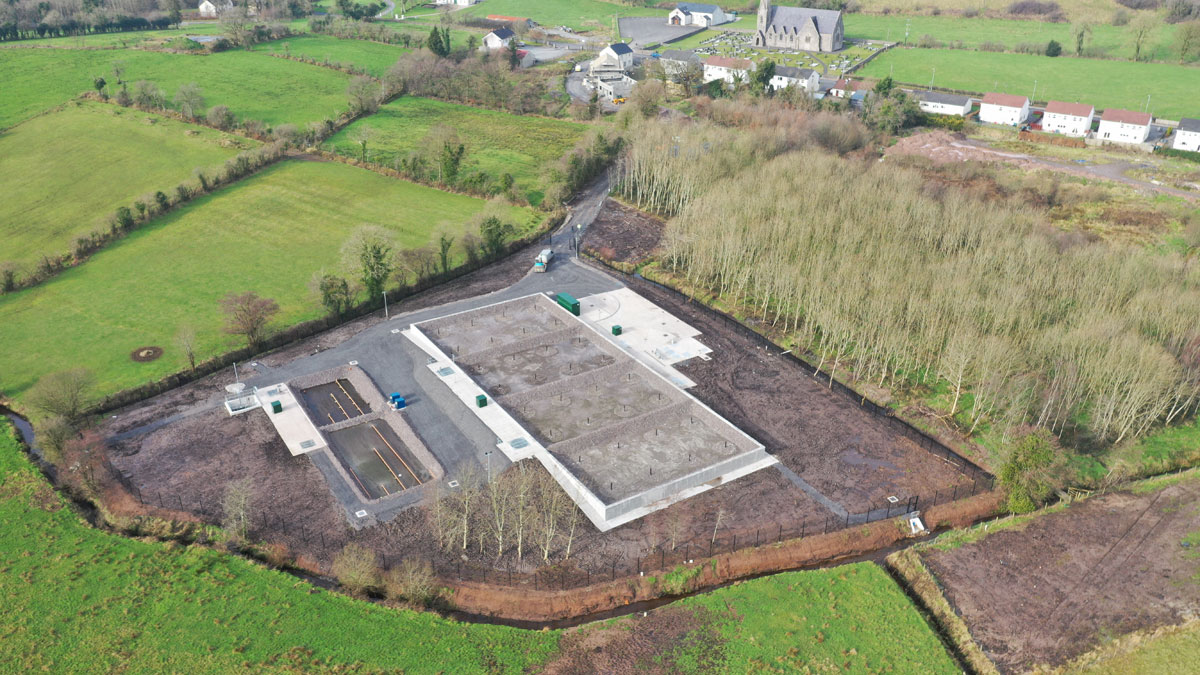
Clabby WwTW: February 2019 – Courtesy of BSG Civil Engineering Ltd
The main benefits of the reed bed system are:
- Smaller footprint than ICW process.
- Provides required level of treatment.
- Sustainability & biodiversity benefits.
Brief description of the work
The proposal included the Phragmifiltre® Stage 1 & 2 concept:
Stage 1
- Up to 4 vertical flow reed beds operating in parallel.
- Flows are fed to each bed in rotation in controlled batches.
- 2 layers of gravel (upper layer fine grade, lower larger grade).
- Beds are fully drained/unsaturated.
- The upper layer traps solids, rags and forms a sludge layer.
- Rotational duty of beds allows dewatering, drying out and composting.
- Biofilm formed on larger gravel media where organic matter is consumed.
- Batch controlled feed allows oxygen to refill voids to aid BOD removal & nitrification process.
- 70% BOD reduction.
- 30% ammonia reduction.
- Effluent from Stage 1 straight to Stage 2.
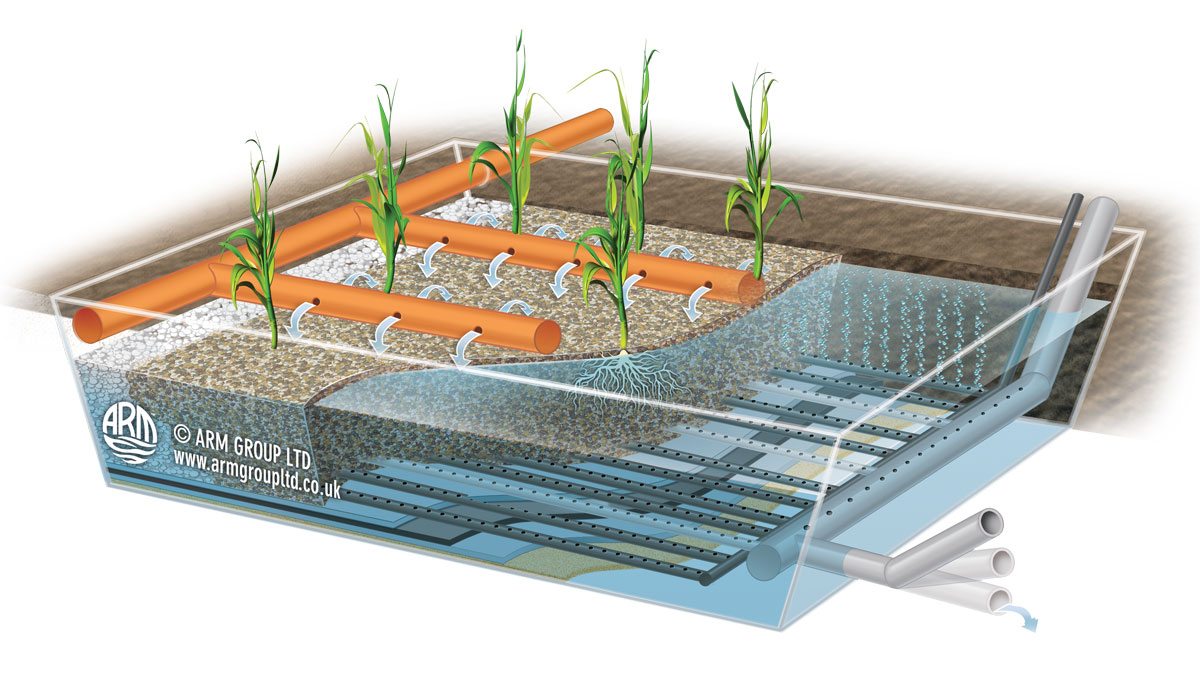
ARM Ltd process schematic – Courtesy of ARM Ltd
Stage 2
- Vertical flow reed beds operating in series.
- Beds are continually fed from Stage 1 effluent.
- Single grade layer of gravel.
- Continually saturated.
- Forced bed aeration (FBA) technology – small aeration units with perforated aeration pipework at the base of each reed bed.
- Mainly for final polishing.
- Completes BOD removal and nitrification process.
- FBA system delivers increased oxygen transfer rate (OTR) improving nitrification.
- Inclusion of FBA system decreases the total footprint.
- Small power requirement.
- Methods for optimising.
- Effluent from Stage 2 passes to final effluent sampling chamber and discharge.
Approval
The NI Water team visited Hulland Ward STW, guided by ARM Ltd and Severn Trent Water. This on site visit allowed NI Water staff from Operations, Scientific Services and Asset Delivery to see first-hand the reed bed system in operation and aided the approval for this pilot scheme in Northern Ireland. A paper was presented to the NI Water Asset Standards Committee detailing the process, operation, performance, maintenance, energy use and costs. Approval was granted to allow concept development by RPS and ARM.
The planning approval process was completed within 10 months – a process which included habitat & ecological surveys, flood risk assessment, drainage assessment & environmental impact assessment determination.
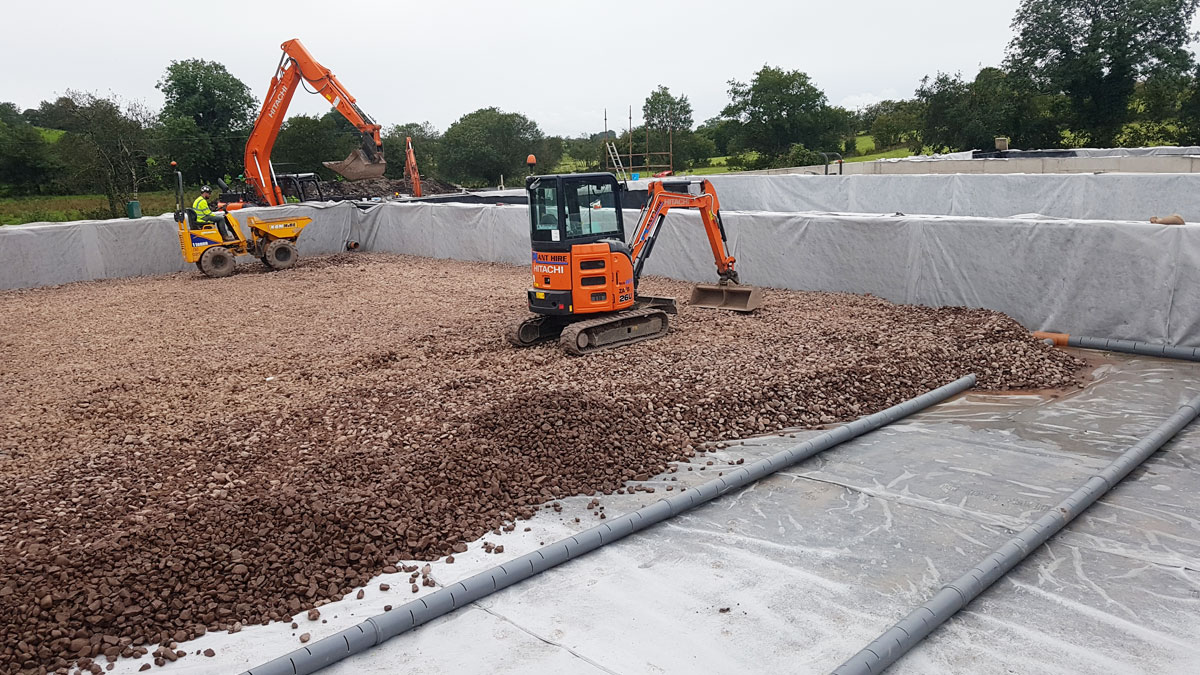
Phragmifiltre® Stage 1 collection pipe and gravel install – Courtesy of BSG Civil Engineering Ltd
Contract procurement
Prior to the construction phase, BSG Civil Engineering Ltd developed the design to spade-readiness through Early Contractor Involvement (ECI); both the design and construction phases were delivered under NEC. Having completed the construction of both the Stoneyford and Castle Archdale ICWs, BSG had experience in the delivery of wetland constructions in Northern Ireland.
The ECI phase saw the detailed design delivery of the contract, in addition to enabling works. Additional site investigation identified varying ground conditions, including a presence of a peat layer. Detailed design was completed with collaborative engagement with all stakeholders including NI Water, RPS, NIEA and BSG’s team, incorporating their inhouse MEICA design engineers, Doran Consulting for civil design and ARM Ltd.
Clabby WwTW: Supply chain – key participants
- Client: Northern Ireland Water
- Principal contractor: BSG Civil Engineering Ltd
- Project management: RPS
- Process design & specialist contractor: ARM Ltd
- Civil design: Doran Consulting Ltd
- MEICA design: BSG Civil Engineering Ltd
- Concrete works: Gleeson Contracts
- Precast piling: DC Piling
- Submersible pumps: Xylem Water Solutions
- Screens: Eliquo Hydrok Ltd
- MCC: Motrol
- Electrical install: Profitec Solutions
- Flow meters: Park Automation
- Control kiosks: Carn Plastics
- Ductile iron pipework: Associated Pipeline Products (APP) Ltd
Engineering solutions to minimise impact
The design development process rationalised the concept proposal, providing a catch-all pumping station to replace an inlet pumping station, a feed pumping station and interstage pumping requirement. The solution increased storage volumes and reduced OPEX costs.
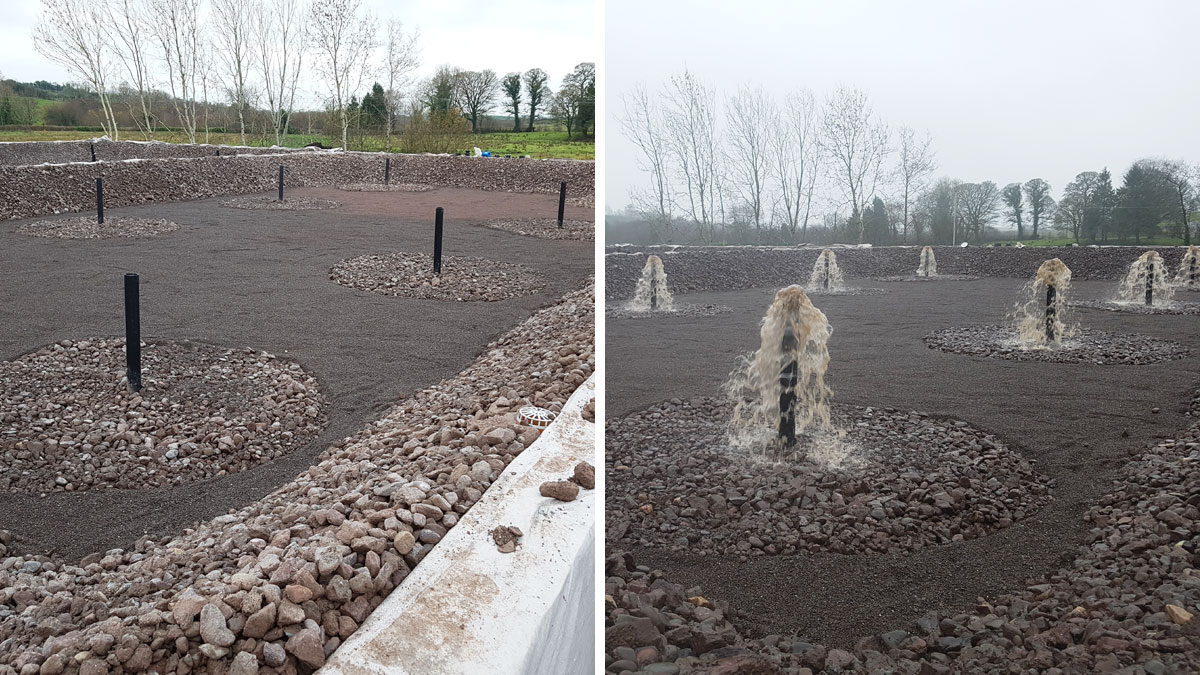
(left) Phragmifiltre® Stage 1 pre-planting and (right) Phragmifiltre® Stage 1 pump trials – Courtesy of BSG Civil Engineering Ltd
Main elements and process
- Placement of gravity main from existing WwTW to new inlet pumping station.
- Construction of new inlet pumping station.
- Construction of 4 (No.) vertical flow Phragmifiltre® reed beds.
- Construction of 2 (No.) saturated vertical flow, forced bed aeration beds (SVF FBA beds)
- Associated level control chambers (LCCs) for both Phragmifiltre® and SVF FBA beds.
- Flow measurement chamber including SIRIS V-notch weir plate, turbidity monitor and dissolved oxygen monitor.
- Outfall headwall including flap valve.
- Control kiosk including a motor control centre (MCC) with programme logic controller (PLC) and human machine interface (HMI).
- Domestic sewage flows by gravity to new pumping station.
- Raw sewage is pumped onto the first stage reed beds in sequence from the pumping station.
- Sewage is distributed evenly across first stage reed bed and percolates down through the layers of gravel and stone to the bottom where it is collected using perforated drainage pipes.
- First stage treated effluent flows by gravity through the level control chambers and onto the SVF FBA Bed 1.
- Effluent is distributed onto the surface of the gravel of the second stage beds using distribution pipes.
- Effluent is held at media surface level to allow an even distribution of effluent across the bed surface. Effluent then percolates down through the gravel layer and is collected by drainage pipework situated on the base of the bed.
- Aeration lines run along the base of the bed parallel to the drainage pipe.
- Treated effluent flows via gravity from SVF FBA Bed 1 to SVF FBA Bed 2 via connecting pipework.
- The process is repeated in SVF FBA Bed 2 and is then discharged via the level control chamber through the flow measurement chamber to the watercourse.
The main process elements were constructed on precast piles to prevent settlement. The Inlet PS was a reinforced concrete structure of depth 7m, with four pumps, each dedicated to the Stage 1 Phragmifiltre® bed.
The 4 (No.) Stage 1 beds were each 15m x 25m in area, constructed in sequence with wall height of 1.85m. Each Phragmifiltre® bed was lined with a membrane and protective geotextile. Specialised pre-slotted collection pipework was installed before the filter stone placement. An approved larger grade stone was placed over the collection pipework.
A distribution pipe was provided with size ranging from 280mm to 110mm diameter and a final layer of fine grade stone was then placed on top.
The second stage SVF FBA beds were constructed in the same way, with the inclusion of an aeration manifold and aeration pipework within the gravel layers.
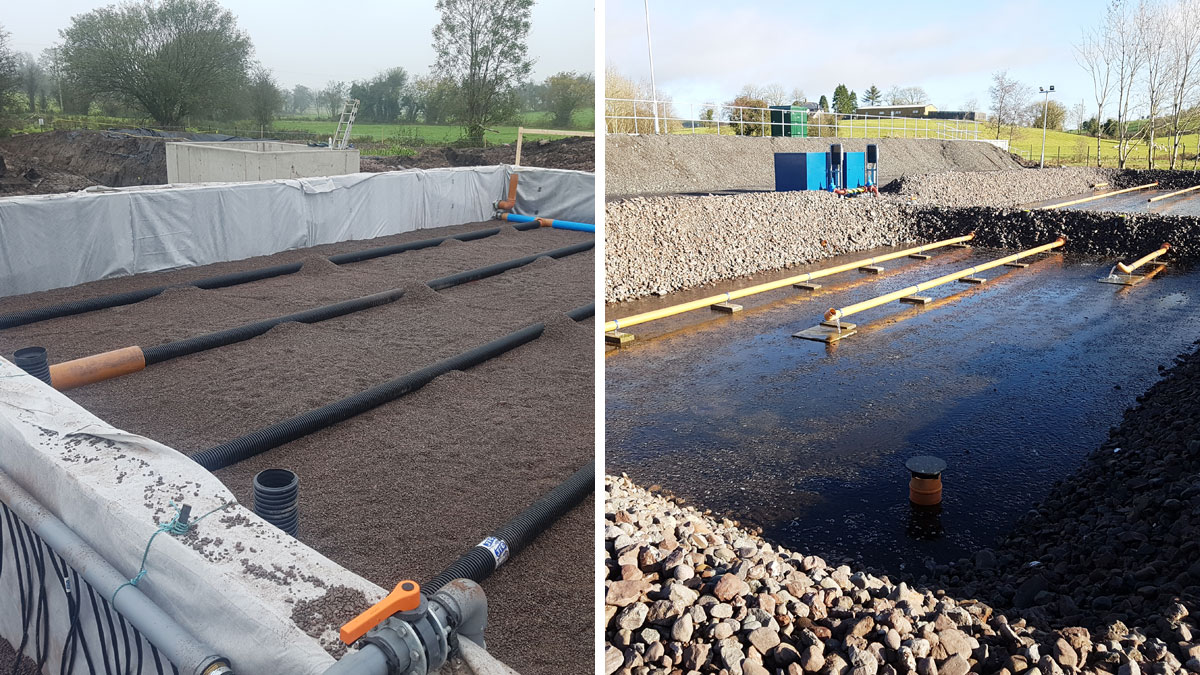
Stage 2 beds construction – Courtesy of BSG Civil Engineering Ltd
Project success and completion
The works had a phased flow diversion, keeping the existing works operational until there was client performance confidence. Full flows to the completed reed bed WwTW were ongoing from November 2018, with testing and commissioning being completed in January 2019. The 28-day trial was successfully completed in early March.
Early life performance
Post-commissioning analysis has been carried out on both the treatment performance and the operational expenditure of the new Clabby Phragmifiltre® system.
The results have been excellent as shown in the table and the graphs below:
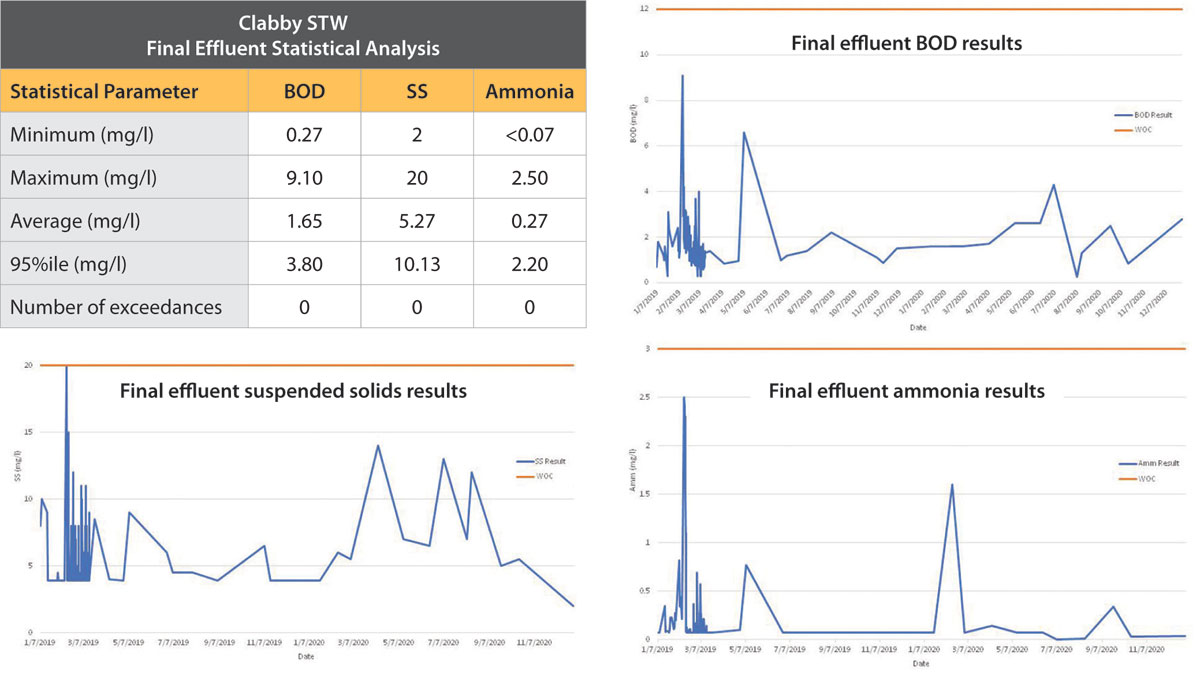
Performance results graphs – Courtesy of RPS
OPEX analysis
Analysis of the operational expenditure of the Clabby Phragmifiltre® system has been carried out and has confirmed that the system is providing treatment at low cost and low operational requirement. The analysis has been compared to other recently constructed conventional treatment systems by the client and has shown to be treating at a much lower cost per population equivalent.
Community engagement
Ahead of construction a number of public relations activities were employed to advise the general public of plans and keep local residents abreast of developments. These included letter drops, and press articles in the local media and on social media. Throughout the construction period, a number of PR and education events were organised.
Continuous stakeholder liaison with Northern Ireland Water, the Northern Ireland Environment Agency (NIEA), churches, elected representatives and the public ensured an incident-free contract.






